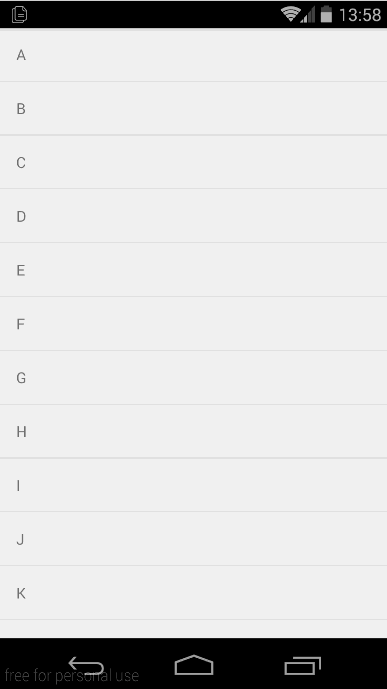1
2
3
4
5
6
7
8
9
10
11
12
13
14
15
16
17
18
19
20
21
22
23
24
25
26
27
28
29
30
31
32
33
34
35
36
37
38
39
40
41
42
43
44
45
46
47
48
49
50
51
52
53
54
55
56
57
58
59
60
61
62
63
64
65
66
67
68
69
70
71
72
73
74
75
76
77
78
79
80
81
82
83
84
85
86
87
88
89
90
91
92
93
94
95
96
97
98
99
100
101
102
103
104
105
106
107
108
109
110
111
112
113
114
115
116
117
118
119
120
121
122
123
124
125
126
127
128
129
130
131
132
133
134
135
136
137
138
139
140
141
142
143
144
145
146
147
148
149
150
151
152
153
154
155
156
157
158
159
160
161
162
163
164
165
166
167
168
169
170
171
172
173
174
175
176
177
178
179
180
181
182
183
184
185
186
187
188
189
190
191
192
193
194
195
196
197
198
199
200
201
202
203
204
205
206
207
208
209
210
211
212
213
214
215
216
217
218
219
220
221
222
223
224
225
226
227
228
229
230
231
232
233
234
235
236
237
238
239
240
241
242
243
244
245
246
247
248
249
250
251
252
253
254
255
|
public class SwipeListLayout extends FrameLayout {
private View hiddenView;
private View itemView;
private int hiddenViewWidth;
private ViewDragHelper mDragHelper;
private int hiddenViewHeight;
private int itemWidth;
private int itemHeight;
private OnSwipeStatusListener listener;
private Status status = Status.Close;
private boolean smooth = true;
public static final String TAG = "SlipListLayout";
public enum Status {
Open, Close
}
public void setStatus(Status status, boolean smooth) {
this.status = status;
if (status == Status.Open) {
open(smooth);
} else {
close(smooth);
}
}
public void setOnSwipeStatusListener(OnSwipeStatusListener listener) {
this.listener = listener;
}
public void setSmooth(boolean smooth) {
this.smooth = smooth;
}
public interface OnSwipeStatusListener {
void onStatusChanged(Status status);
void onStartCloseAnimation();
void onStartOpenAnimation();
}
public SwipeListLayout(Context context) {
this(context, null);
}
public SwipeListLayout(Context context, AttributeSet attrs) {
super(context, attrs);
mDragHelper = ViewDragHelper.create(this, callback);
}
Callback callback = new Callback() {
@Override
public boolean tryCaptureView(View view, int arg1) {
return view == itemView;
}
@Override
public int clampViewPositionHorizontal(View child, int left, int dx) {
if (child == itemView) {
if (left > 0) {
return 0;
} else {
left = Math.max(left, -hiddenViewWidth);
return left;
}
}
return 0;
}
@Override
public int getViewHorizontalDragRange(View child) {
return hiddenViewWidth;
}
@Override
public void onViewPositionChanged(View changedView, int left, int top,
int dx, int dy) {
if (itemView == changedView) {
hiddenView.offsetLeftAndRight(dx);
}
invalidate();
}
public void onViewReleased(View releasedChild, float xvel, float yvel) {
if (releasedChild == itemView) {
if (xvel == 0
&& Math.abs(itemView.getLeft()) > hiddenViewWidth / 2.0f) {
open(smooth);
} else if (xvel < 0) {
open(smooth);
} else {
close(smooth);
}
}
}
};
private Status preStatus = Status.Close;
private void close(boolean smooth) {
preStatus = status;
status = Status.Close;
if (smooth) {
if (mDragHelper.smoothSlideViewTo(itemView, 0, 0)) {
if (listener != null) {
Log.i(TAG, "start close animation");
listener.onStartCloseAnimation();
}
ViewCompat.postInvalidateOnAnimation(this);
}
} else {
layout(status);
}
if (listener != null && preStatus == Status.Open) {
Log.i(TAG, "close");
listener.onStatusChanged(status);
}
}
private void layout(Status status) {
if (status == Status.Close) {
hiddenView.layout(itemWidth, 0, itemWidth + hiddenViewWidth,
itemHeight);
itemView.layout(0, 0, itemWidth, itemHeight);
} else {
hiddenView.layout(itemWidth - hiddenViewWidth, 0, itemWidth,
itemHeight);
itemView.layout(-hiddenViewWidth, 0, itemWidth - hiddenViewWidth,
itemHeight);
}
}
private void open(boolean smooth) {
preStatus = status;
status = Status.Open;
if (smooth) {
if (mDragHelper.smoothSlideViewTo(itemView, -hiddenViewWidth, 0)) {
if (listener != null) {
Log.i(TAG, "start open animation");
listener.onStartOpenAnimation();
}
ViewCompat.postInvalidateOnAnimation(this);
}
} else {
layout(status);
}
if (listener != null && preStatus == Status.Close) {
Log.i(TAG, "open");
listener.onStatusChanged(status);
}
}
@Override
public void computeScroll() {
super.computeScroll();
if (mDragHelper.continueSettling(true)) {
ViewCompat.postInvalidateOnAnimation(this);
}
}
public boolean onInterceptTouchEvent(MotionEvent ev) {
final int action = ev.getAction();
if (action == MotionEvent.ACTION_CANCEL) {
mDragHelper.cancel();
return false;
}
return mDragHelper.shouldInterceptTouchEvent(ev);
}
public boolean onTouchEvent(MotionEvent event) {
mDragHelper.processTouchEvent(event);
return true;
};
@Override
protected void onFinishInflate() {
super.onFinishInflate();
hiddenView = getChildAt(0);
itemView = getChildAt(1);
}
@Override
protected void onSizeChanged(int w, int h, int oldw, int oldh) {
super.onSizeChanged(w, h, oldw, oldh);
itemWidth = itemView.getMeasuredWidth();
itemHeight = itemView.getMeasuredHeight();
hiddenViewWidth = hiddenView.getMeasuredWidth();
hiddenViewHeight = hiddenView.getMeasuredHeight();
}
@Override
protected void onLayout(boolean changed, int left, int top, int right,
int bottom) {
layout(Status.Close);
}
}
|
